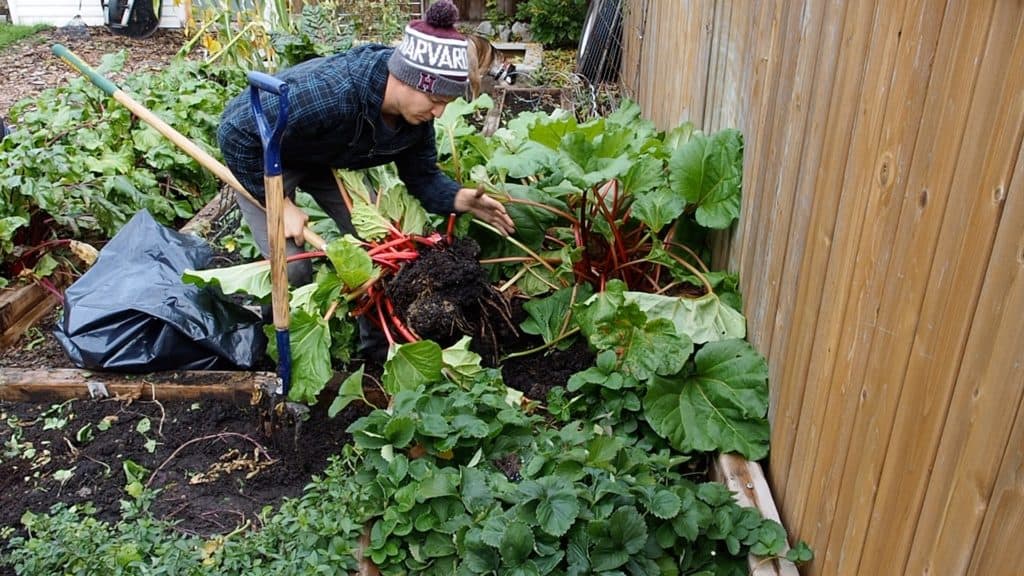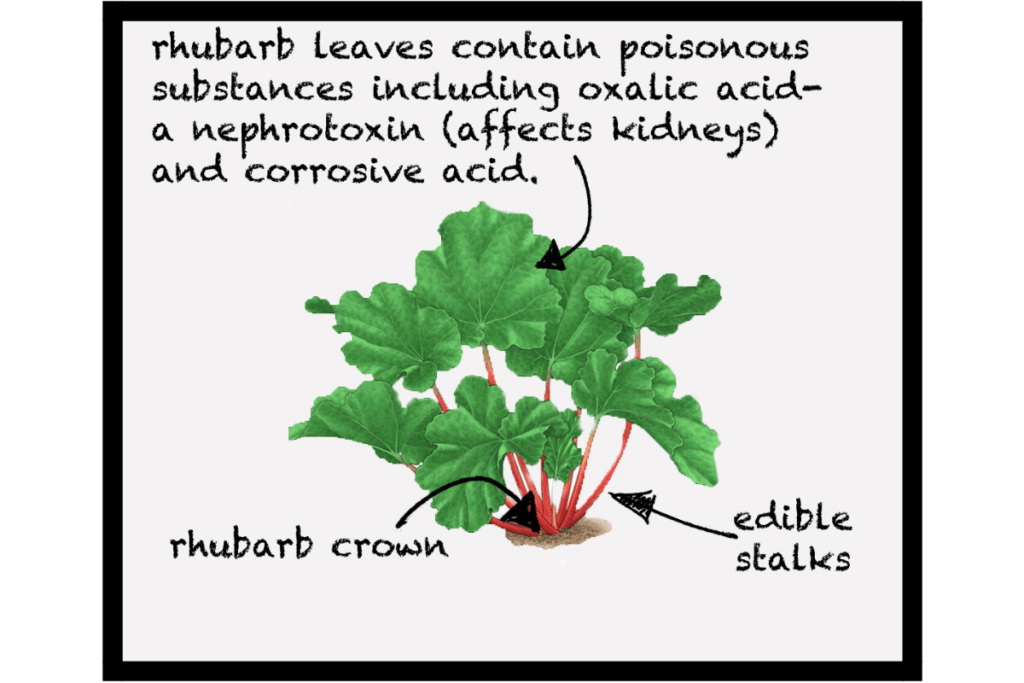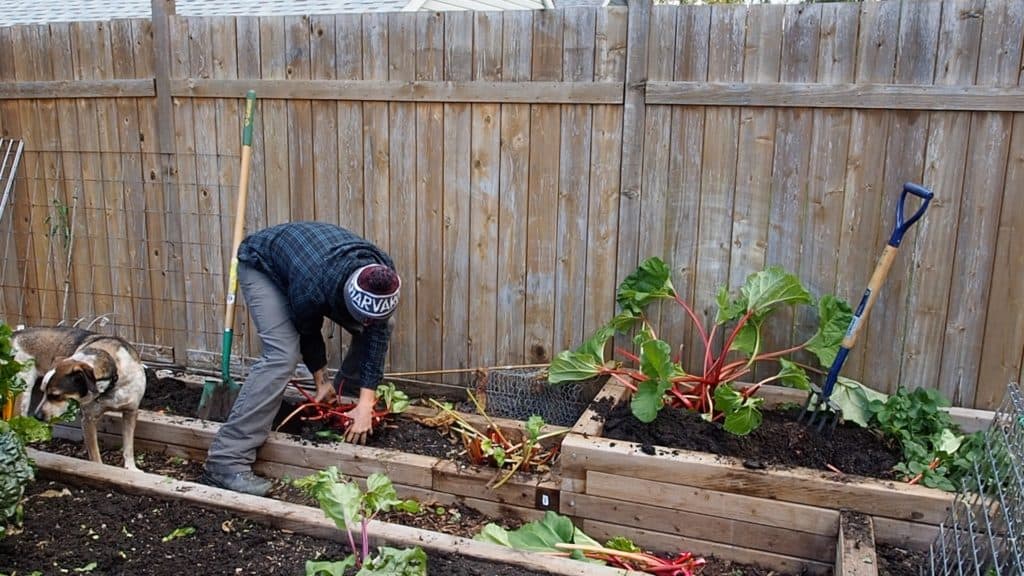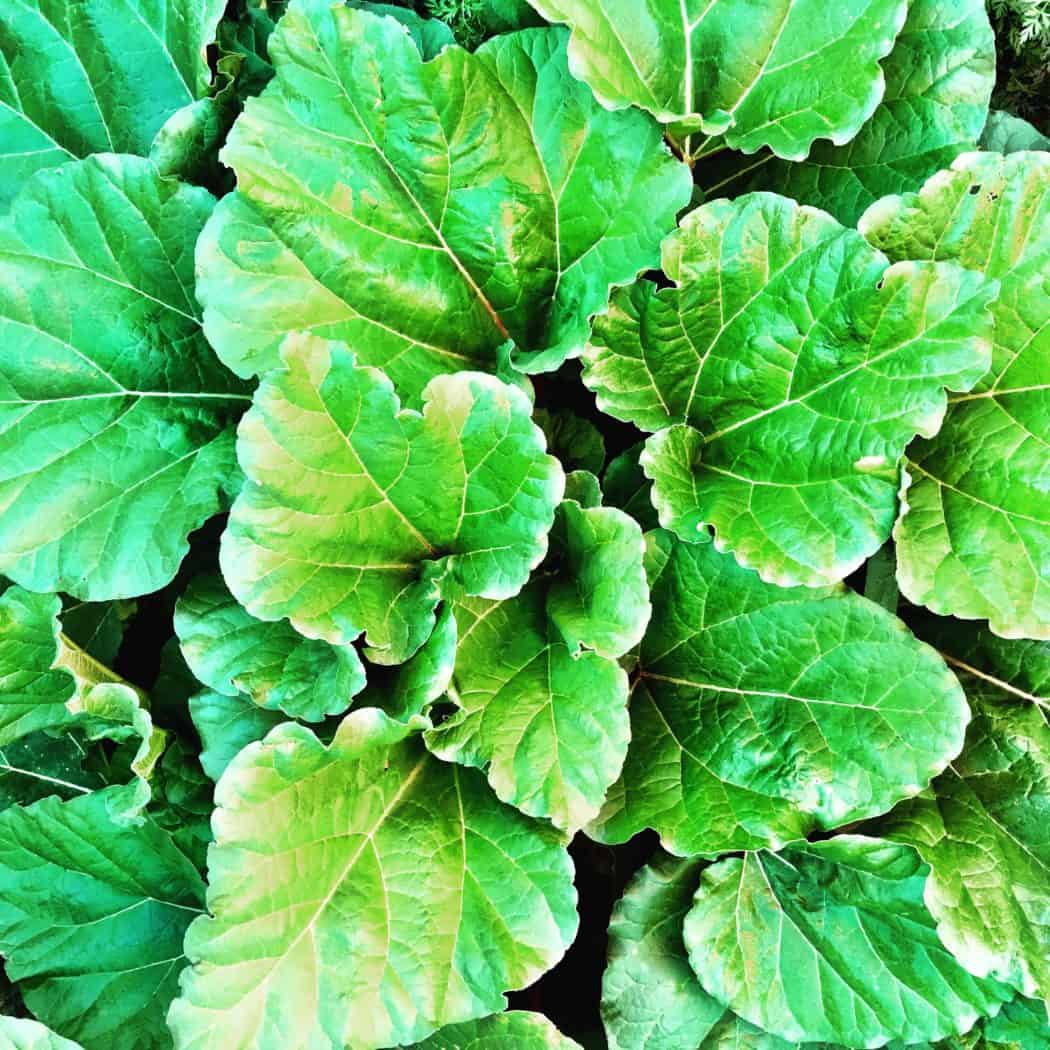Transplanting rhubarb becomes a necessity no matter how good the gardener or how nice the garden. Transplanting rhubarb is done to increase the size of your rhubarb garden, to decrease the size of your rhubarb garden, and to maintain healthy plants. This is a great task to tackle in the fall when you are already preparing your vegetable garden for winter.
Before I get into the how, when, and where to divide, take a few moments to watch our video about transplanting rhubarb.
Rhubarb (Rheumrhabarbarum) is one of several perennial vegetables you can cultivate in your garden at home. Rhubarb grows best where winter temperatures drop below 40 degrees Fahrenheit/-17 degrees Celsius (plant hardiness zones 3 through 6). The cold period is necessary for the plant to break dormancy and grow. Because its roots get old and gnarly, rhubarb division is required every four to six years.
Transplanting rhubarb: The WHEN
Transplanting rhubarb can be done in early to mid fall or early spring once the ground has thawed. Fall is often the preferred time of year because the plant has gone dormant for the season and will endure less stress during transplanting.
Regardless the time of year, the method by which we transplant rhubarb remains much the same.
Transplanting rhubarb: The HOW
1) Transplanting rhubarb – whole plant
This is the what we set out to accomplish in the video above. Insert the blade of your spade at least 6 inches into the soil around the entire base of the rhubarb clump. I will often use a 4 tine spading fork (or perennial fork as I call it) in conjunction with a square spade. This has been the best combination to help avoid cutting the rhubarb roots. Slowly work the spade beneath the root mass and lever it backward to lift the entire root clump from the bed. Once again, try and avoid cutting the root ball.

2) Transplanting rhubarb – increasing the size of your rhubarb garden
The propagation of rhubarb plants to increase the size of your rhubarb garden involves dividing the crown and root system of the plant. This can be done by propagating from 4 to 5 year old crowns (rhubarb plants). Just like above, the entire plant can be dug up as one large root ball. Locate the crown (the part of the plant right near the soil) and look for the rhubarb buds or eyes (young growth). Use a sharp spade to divide the clump (be careful not to damage the crown), so that each portion has both part of the root and crown of the original plant. Ideally, you would like 2-3 eyes per division.
Just like with other perennials, the larger the crown (or clump of plant), the quicker it will become established.
3) Transplanting rhubarb – decreasing the size of your rhubarb garden and maintaining healthy plants
Eventually, your rhubarb clumps become too large and the eyes on each crown become crowded. Smaller or thinner leaf stalks can be a sign that it is time to divide your rhubarb plants. Many rhubarb patches will continue to produce a good harvest for 15 years or more. Although the best rhubarb yields will typically come from patches that are about 8-10 years or younger. A good rule of thumb is to divide the plants every 5 to 6 years in fall or early spring.
It is advisable to divide or transplant only half of your plants each year. This will guarantee a good harvest while your transplants re-establish. Try not to leave any roots or pieces of the rhubarb crown behind, as they are sometimes enough to grow back volunteer rhubarb.

Transplanting rhubarb: The WHERE & Re-planting
The beauty of rhubarb is it’s adaptability. Rhubarb will thrive in full sun or light shade, all but guaranteeing you at least one location it will flourish in a yard.
Digging your hole, planting, and backfilling
For each crown that requires transplanting, dig your hole 4 inches deeper and 1.5 times as wide as your root ball. Add some loose soil to bottom of your hole then add your rhubarb crown. Make sure the crown is even with the surrounding soil level.

Backfill the hole with loose soil and compost (if available), firming it around the roots but not directly over the bud. Water thoroughly and keep the soil moist at all times, watering once or twice weekly as needed.
Things you will need to transplant rhubarb:
- A spading fork (perennial fork)
- A square spade
- Compost
- If you run into really old roots, you may need a hori-hori knife. If you have never heard of this tool before, check out our post on this amazing little gardening tool.
Optional: Mulch the bed with a 3-inch layer of straw. New growth typically begins to emerge within four weeks of transplanting rhubarb.



Having read this I believed it was very enlightening.
I appreciate you taking the time and energy to put this information together.
I need to move my rhubarb soon because of a remodeling project. What are the chances of survival? I’m in MN, it’s hot and it’s probably years overdue for splitting. I know, I’m a bad rhubarb mom😬
Off to try and transplant a Rhubarb crown – will comment when done and rhubarb has started growing in my garden! Thanks for the help.
Best of luck! It can take a few weeks for the crown to re-root itself depending on your location, so be patient!
I hope to be moving house during the next 6 months – maybe less! At what stage is it best to lift the rhubarb crown and how long is it safe to leave before replanting in my new garden?
Hi Margarette,
In my neck of the woods we typically transplant rhubarb in the spring when new shoots are just starting to poke out of the dirt. I would try not to leave it for too long without replanting it in some manner. If it’s just a few days, then keeping the dirt ball and crown moist inside a plastic bag will be fine. Past a few days, I would consider planting it in a temporary pot until you are ready to put it in the ground. Rhubarb is incredibly hardy and as long as you have a solid piece of crown and don’t let it dry out, you should have success. Good luck!
what are good companion plants for rhubarb
Great question- Personally I have strawberries as my companion plants for rhubarb. The relationship is very much mutually beneficial. In addition they are both harvested starting at roughly the same time, and both benefit from a covering of straw. Some other good companion plants include anything in the Brassica family. This includes broccoli or cauliflower, cabbages, or kale.
Do I wait a year before harvesting from the transplanted rhubarb?
Hi Gail- there is no need to wait a full year. If the crown roots well you should have stalks that season. However, be sure to wait until you have a full plant. Harvesting prematurely could negatively impact future growth and production.
I am gifting a large rhubarb plant to a friend & we love in CO. Today it is 90 degrees, but we are supposed to have snow on Tuesday & temps dropping to 30’s. Should I dig it up now and have her plant it immediately or wait until after the storm? Or, wait altogether until Spring?
I would wait until after the storm and then try and transplant it this fall. There should still be enough time for the crown and roots to settle into their new home. It will make for a much happier plant come spring time!
I want to transplant a rhubarb plant. We are expecting an early freeze/snowfall. (however the snow will melt fast and the temps will go back up to 80 again within a few days. Can I dig it up before the freeze and hold as you have described for a couple days and then get it back in the ground. Should I just wait until after the freeze and then transplant, or wait til spring?
Never mind , the person just ahead of me must be a neighbor! I see your answer.
Thank you for your clear directions. I was worried about moving the plant incorrectly, 3 yr old) but this has given me excellent info.
Thank You for the information. Plan on doing some transplanting soon.
I bought a rhubarb root last year ( In a box). The plant has grown and the leaves are very large. I made a mistake plating it near the house. Can I transplant it in another area now? The weather is in the 60’s and 70’s in Pittsburgh, Pa.
I’ve been offered a large, producing rhubarb from a friend who just moved and inherited it. It is ready to be harvested now, late spring in the Pacific Northwest, Puget Sound. Weather now, mid-May, is consistently above freezing, with mostly warm 70 degree days, and a few cooler 40s/50s) & rainy days. Won’t get consistently hot here till mid-July or so. Okay to transplant it now, or should we wait till fall?
There is no problem in transplanting it now. Take a harvest off the plant, then go for it. The only catch being, you likely won’t get many harvests this year. You should focus on letting the transplant redevelop it’s crown and root into its new home. I transplanted my own two plants at this time last year and they look fantastic this spring.
I’m in Colorado and with our crazy weather I didn’t get the rhubarb plants transplanted before they started to take off. I’ll be transplanting next weekend hopefully now. Should I go ahead and harvest prior to transplant or leave as is and not harvest at all this year? Also I’m going from in ground in front of the house to 24x24x24 cedar planter boxes. Only 1 plant per box, correct?
Definitely harvest before transplanting. You want the rhubarb to focus on root and crown development and not stalk and foliage. I would only do one plant per box. Better to have a strong healthy plant that produces well, than two weaker ones.
The dear love my rhubarb leaves. I needed to transplant behind a fenced area. I was worried that Sept was the wrong time. Thanks for the transplanting info. Very helpful!
I noticed some sort of a beetle eating the leaves on my rhubarb they are black and gold colored is there anything I can use to stop this and what are these beetles called. Thank you for any help
I just received a large rhubarb plant. We split it into two plants. I watered it last night after planting. Today, when the sun was hitting it, all the leaves and stalks wilted. I watered it at noon. I gave each about 1/2 gallon of water. The leaves are flat on the ground now (5 pm). How often should I water it and is this normal?
I am in the process of moving from northern ND to western, northern MT for retirement, and want to take my Canadian Red Chipman Rhubarb plant with me. Is this permissable? I really love this plant for the sweet, abundant, red stalks, folks tell me it is the best tasting of all the plants around, their’s are all the green stem type.
I would say as long as you have some of the crown, it will transplant.